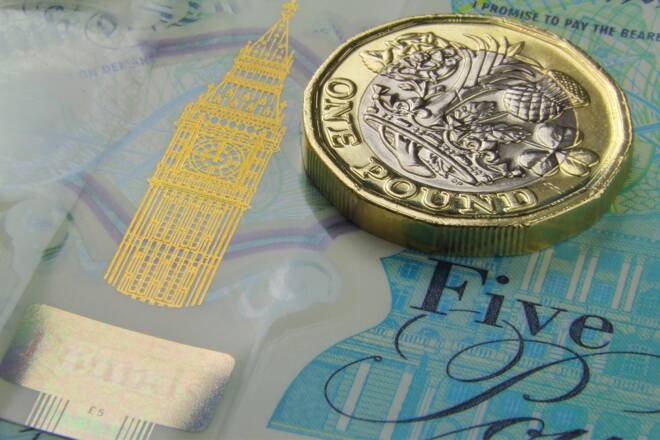Advertisement
Advertisement
GBP to USD Forecast: UK Wage Growth Accelerates to Test the BoE Pause Theory
By:
The Sterling faces economic headwinds as UK labor market news impacts the GBP/USD currency dynamics.
Highlights
- GBP/USD rose 0.36% on Monday, recovering from Friday’s 0.06% loss, closing at $1.25089.
- Wage growth trends may challenge the BoE’s rate stance, with average earnings plus bonuses up 8.5% in July.
- Upcoming US CPI figures cast shadows on investor sentiment; a hotter report might reignite Fed rate hike talks.
Overview of Monday’s Performance
The GBP to USD pair rose by 0.36% on Monday. Reversing a 0.06% loss from Friday, the GBP/USD ended the day at $1.25089. A choppy session saw the pair fall to a low of $1.24631 before rising to a high of $1.25480.
UK Labor Market Overview Moves the GBP/USD
The UK Labor Market Overview Report drew significant interest this morning. Last week, Bank of England Governor Andrew Bailey poured cold water on further BoE interest rate hikes.
The BoE Governor expects a sharp fall in inflationary pressure before the end of the year, removing the need for further rate hikes. However, tighter labor market conditions or a pickup in wage growth could test the pause theory.
Tighter labor market conditions lead to an upward trend in wages. Higher wages would fuel consumption and demand-driven inflation. Raising interest rates typically counteracts these effects, dampening labor markets, wage growth, and consumption.
UK Wage Growth to Test the BoE Pause Theory
The UK unemployment rate rose from 4.2% to 4.3% in July. However, wage growth accelerated in July. Average earnings + bonuses rose by 8.5% in July versus 8.4% in June. Economists forecast the UK unemployment rate to increase from 4.2% to 4.3% and for average hourly earnings + bonuses to rise by 8.2%.
The wage growth figures will draw the interest of Monetary Policy Committee members.
US CPI Report Looms Large
Easing market bets on further Fed rate hikes continued to impact investor appetite for the dollar. Investors are expecting softer US core inflation figures to support the Fed ending its interest rate tightening cycle.
According to the CME FedWatch Tool, the probability of a September Fed hold on interest rates was 93% versus 92% on Friday. In contrast, there was a 57.6% chance of a November pause versus 53.0% on Friday.
The shift in sentiment toward the Fed interest rate outlook leaves the GBP/USD at risk of a sharp pullback.
Hotter-than-expected US core inflation figures could refuel Fed rate hike bets. No FOMC members are on the calendar to speak ahead of the US CPI Report. The FOMC entered the blackout period on Saturday. FOMC members refrain from discussing monetary policy during the blackout period.
Short-Term Forecast
Macroeconomic indicators suggest further downside potential for the GBP/USD pair despite the wage growth numbers. However, a shift in sentiment toward the Fed interest rate trajectory would offer near-term GBP/USD support.
GBP to USD Price Action
Daily Chart
The GBP/USD pair sat below the trend line. However, the GBP/USD held above the 200-day EMA while remaining below the 50-day EMA. The EMAs sent bearish near-term but bullish longer-term prices signals.
The rise in the UK unemployment rate should ease upward forces on wage growth, allowing the BoE to hit the brakes on rate hikes. Should the GBP/USD break below the 200-day EMA, it could approach the $1.24410 support level.
However, rising bets on BoE rate hikes to tame inflation would support a run 50-day EMA and $1.26815 resistance level.
The 14-period daily RSI reading of 38.50 shows the GBP/USD pair can fall to the $1.24410 support level before entering oversold territory.
4-Hourly Chart
The GBP/USD remains below the 200-day and 50-day EMAs, reaffirming bearish price near-term signals. A GBP/USD break above the 50-day EMA would give the bulls a run at $1.26 and the 200-day EMA. However, the GBP/USD would need BoE commentary to affirm the need to tackle wage growth to target the 200-day EMA.
The 48.10 14-period 4-hourly RSI shows the GBP/USD can retest the 1.24410 support level before entering oversold territory.
About the Author
Bob Masonauthor
With over 28 years of experience in the financial industry, Bob has worked with various global rating agencies and multinational banks. Currently he is covering currencies, commodities, alternative asset classes and global equities, focusing mostly on European and Asian markets.
Advertisement
